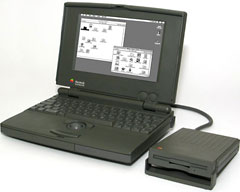
PowerBook 100 with floppy drive.
Twenty years ago, Apple introduced its first laptop computer - the16 lb. Macintosh Portable wasportable, but definitely not a laptop - and forever changed the face ofnotebook computing. Although we take it for granted that laptops have atrackpad mounted in front of the keyboard, that was a completely newdesign that arrived with the first generation of PowerBooks (the100, 140, and 170) on October 21, 1991.
Our staff looks back at the legacy of those first PowerBooks,as well as other ways that Apple has redefined notebook computing.
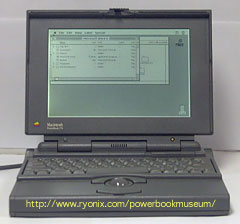
PowerBook 170
Dan Knight (Mac Musings): I worked inthe local ComputerLand store when the first PowerBooks were introduced,and I remember the biggest problem was getting enough units to keep ourcustomers happy. The top-end PowerBook 170 was especially popular, andwhen the PB 180 replaced it a yearlater, it had the same supply problem.
The PowerBook design really was revolutionary in 1991. PC notebooksoften had blue displays, and if you wanted a pointing device, you couldtake along a mouse or find a clip-on trackball - which often had to beremoved before you could close your laptop.
Contrast that with Apple's front-and-center trackball, which meantmoving the keyboard back and creating a built-in wrist rest.
That was only the start of Apple innovation. Apple had the firstnotebooks with color displays, stereo sound, trackpads, smartbatteries, and WiFi. It introduced widescreen displays with the first PowerBook G4 in2001, which was also remarkably slim at just 1" thin. The first MacBook Air (2008) raisedthe ante for small and light computing, running circles aroundunderpowered Atom-based netbooks with a true Core 2 Duo CPU,introducing a machined unibody aluminum case, and still managed afull-size keyboard. Two years later, the 11.6" MacBook Air kept all ofthose advantages while becoming even lighter.
Apple has a long record of innovation, and most of its innovationsin the notebook range have become normal features across theindustry.
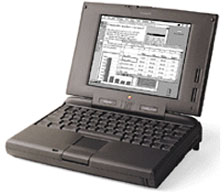
PowerBook 5300
Charles Moore (severalcolumns): I missed the beginning of the PowerBook era by ayear, becoming a Mac user in the fall of 1992, and initially withdesktop machines. I played around a bit with 100 series PowerBook onrare occasions when I could get my hands on one, and it didn't takelong to decide that I really wanted one, but that didn't happen untillate 1996, when I picked up a remaindered PowerBook 5300 (the entry-level,grayscale display model at what seemed at the time to be anattractively discounted price of CAN$1,895 - how times havechanged!).
In addition to being the first PowerPC PowerBook, the 5300 also hasthe distinction of being the most expensive laptop Apple ever sold. thePowerBook 5300ce, which at a suck-in-your-breath $6,500, (about $8,500in Canadian dollars at the time) has the dubious distinction of beingthe most expensive Mac laptop ever, at a whopping $4,300 more than theentry level PowerBook 5300 that sold for $2,200.
The punch line was that both of these computers shared the same formfactor, motherboard architecture, keyboard, and case plastics. For thatextra $4,300 what you got was a 1% faster 603e processor (117 MHz vs100 MHz), a very nice 10.4" 800 x 600 active-matrix display instead ofa 9.5" passive matrix grayscale unit, a 1.1 GB instead of a 500 MB harddrive, and standard 32 MB instead of 8 MB of RAM. A bit of Appleprofiteering I think, even at the astronomical RAM prices of the day (Ihazily recall paying about $225 for a 16 MB stick to bring my 5300 upto 24 MB, which incidentally was enough to boot into a RAM disk thatcould hold a stripped down OS 8.x, MS Word 5.1, and some smaller apps,dispensing with even the hard drive noise while gaining somemuch-needed speed.
The PowerBook literally changed my life. It took me about half a dayafter I unboxed the 5300 realize that portables were the way I wantedto go with computing, and I've never really looked back except for abrief dalliance with a G4Cube in 2001 and picking up a brand new Umax SuperMac S900 clone tower for anirresistible $300 in the early '00s.
At the outset, I hadn't expected the laptop to essentially replacemy desktop Mac, but that's what happened virtually overnight, leavingme wondering whether there was any logical case for most people to owna desktop computer at all. I wonder even more these days. Never say"never", but I don't perceive much likelihood that I'll ever buyanother desktop Mac, at least as my main workhorse computer. I'm reallynot comfortable anymore using a machine that doesn't supportbattery-powered, portable operation.
The PowerBook/iBook/MacBook has always seemed "right" to me, evenwhen used primarily as a desktop machine. Non-laptops, even small oneslike the Mac mini, have therestrictive handicap of needing an umbilical to wall current. Thecompact, self-contained quality of the PowerBook allowed a lot moreflexibility in terms of work venues, and a laptop workstation doesn'tdominate a room.
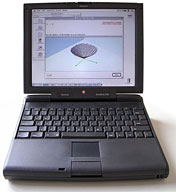
PowerBook 3400c
Another traditional advantage of the PowerBook was its quietness. Upuntil the PowerBook 3400c in2007, PowerBooks didn't have internal cooling fans, so there was nopossibility of a noisy cooling fan droning away. Even after thePowerBooks got fans, they rarely cut in unless you were toiling in veryhot conditions.
The PowerBook changed the paradigm for many of us from "do I reallyneed a laptop?" to "do I really need a desktop machine?"
Some users really do need the power and expandability of a desktopMac, but most of us discovered that we didn't, especially after the G3PowerBooks arrived in the late '90s (followed by G4 PowerBooks in the'00s) with enough performance to satisfy all but the most demandingpower-users.
Too bad Apple chose to retire the PowerBook name in 2006 in favor ofthe much blander MacBook branding. The hardware remained great,however, and the legacy of those first PowerBook 100s lives on intoday's Apple laptops - and indeed across the notebook computerspectrum. Notwithstanding the touchslab's current popularity, for me thePowerBook set a bar so high that the essential concept has yet to besurpassed.
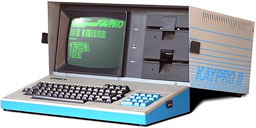
Kaypro II portable computer
Allison Payne (The BudgetMac): I remember the first "portable" computer I everused. Well, really, "luggable" would be more descriptive. It was a30-pound monsterthat, when closed, was its own carrying case. The monochrome 9" screenand two 5.25" floppy drives were my gateway into personal computing atthe age of five.
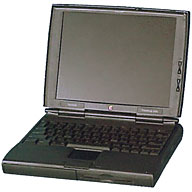
PowerBook 1400
I never even saw an Apple laptop until college, fifteen years later,and by then Apple was well into the G3"IceBook" era. I missed the entire 68K PowerBook era and onlyrediscovered the various innovations that we now take for granted in mymid-20s. Small form-factor, long battery life, swappable bays - heck,even the interchangeable BookCover on the PowerBook 1400 foreshadowed the trend toindividualize laptops with screen-printed designs, laser-etching, andcustomizable skins.
Many of those innovations have faded into the background as Applehas streamlined its models and simplified its designs, but some of thecore values still persist and are even making a comeback:ultra-portability, for example, with the newest MacBook Air models. Andas with so many other things, where Apple leads, we see the rest of theindustry scrambling to catch up and get a piece of the profits.
Dan Bashur (Apple, Tech, andGaming): I once marveled at the ads for PowerBooks in theMacMall print catalogs that would arrive in our mailbox during my highschool years, with some clear memories (later in college) of beingabsolutely blown away with the specs of the 3400c, which was touted atthe time as the most powerful laptop in the world.
I could always dream, but as a family we were grounded to the beigedesktop Macs due to the prohibitive cost of earlier PowerBooks whichseemed to average between the $3,000 and $5,000 price point. I evenremember the high-end variety of the 3400c released in 1997 that toppedoff around $6,500! Needless to say, no PowerBook (new or used) waswithin our family budget growing up, nor within my personal budget as acollege student in the mid to late 90s.
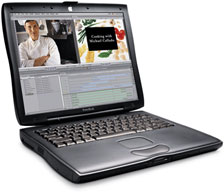
Pismo PowerBook
That would all change as these machines hit the used market andbecame increasingly low-end during the Intel age. I now have a 400 MHz Pismo PowerBook G3, two500 MHz Titanium Power Mac G4s (a resurrection project), and a 12" 1.5 GHz PowerBook thatreplaced a 15" 1.67 GHzHi-Res PowerBook that I sold in order to obtain the 12" and a SonyPlayStation 3. PowerBooks have been a part of my daily life for fouryears, and it would be hard to imagine being a journalist withoutone.
The name PowerBook says it all - a notebook filled with power. Thepower to create, the power to think different, and the power to bewhatever you want to be. As great as the MacBook Pro is, its name willnever have the panache and ring to it that PowerBook did.Here's hoping that Apple brings back the PowerBook brand someday!
Simon Royal (Tech Spectrum): I jumpedinto the PowerBook market quite late. I had used Mac desktops foryears, but I needed a laptop and at the time went with a Windows basedToshiba, but I just couldn't bear to use it, so I started looking foriBooks and PowerBooks.
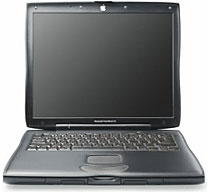
Lombard PowerBook G3
I picked up a LombardPowerBook G3 in 2007, loved it, and upgraded it to the max. Then Imoved on to 400 MHz Titanium PowerBook G4, which was a massiveimprovement over the Lombard. Since then I have owned over 15 variousiBooks and PowerBooks - going all over the place in specs from iBookClamshell (Indigo 366 MHz), iBook G3 (2x 500 and an 800 MHz), severalLombard PowerBook G3 (333 and 400 MHz), a couple of Pismo PowerBook G3(400 and 500 MHz), a WallStreet PowerBook G3 (233MHz), a PowerBook 1400cs (117 MHz), and Titanium PowerBook G4 (two 400,a 500 and 867 MHz).
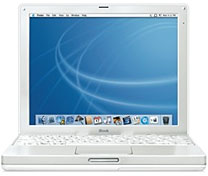
12" iBook G4
I am currently using a 1.07 GHz iBook G4. I have haddesktop Macs in the meantime, but even armed with an Intel iMac (Early 2006), Ipreferred to use the even then aging Lombard.
PowerBooks hold a fondness for me, due to the high durability,quality build, longevity, and being so easy to upgrade. Installing anew hard drive takes only a few minutes and a handful of screws asopposed to iBooks, which take at least 30 min. and 30+ screws.
Macs have always been more powerful than their PC counterparts, andPowerBooks - being aimed at the business user - have always had amassive edge over the consumer aimed iBooks. Even the name tells you itis a beast of a computer. Switching to the MacBook name just isdescriptive - it's a Mac and it's a 'Book - but it doesn't have thesame assertiveness that PowerBook does.
I can't see myself moving to a desktop ever in the future.
Austin Leeds (Apple Everywhere): Asthe owner of a PowerBook 180 (which unfortunately took a nasty fallonto concrete yesterday, but seems to have survived unscathed - goodol' USA workmanship), and the former owner of a contemporary PC laptop(AT&T Globalyst), I can see quite clearly the impact that thePowerBook line made right off the bat, and the impact that the MacBookPro line continues to make today. Apple is quite often at the forefrontof innovation in the mobile field - whatever they don't invent, theymake affordable, reliable, and popular.
From the trackpad to colored screens, from WiFi to SSDs, Apple'smobile devices have been the best in their field and will undoubtedlycontinue to be so for some time to come.
Further Reading











